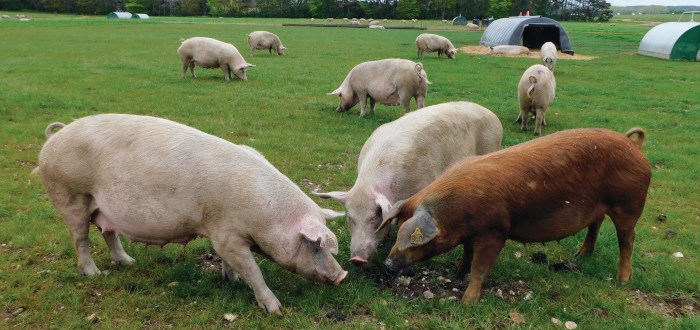A collaborative project on a Norfolk pig farm has demonstrated the multiple benefits to pig producers, landlords and the environment of having grass cover on outdoor sites. JANE JORDAN reports.
A three-year project to find out if maintaining grass cover on outdoor pig sites could prevent soil erosion and protect ground water quality has demonstrated benefits beyond those it set out to achieve.
The collaboration between the Norfolk Rivers Trust, Anglian Water and seed specialist Kings, with support from AHDB Pork, has shown that establishing a pig-specific grass sward, and managing it to enable green cover to be sustained throughout the pigs’ occupancy, can promote healthy soils, improve soil structure and enhance the nutrient capturing capacity of free-draining land. These are all advantages arable farmers will find valuable in successive cropping and within their soil protection/ground care strategies.
The trial has also shown potential savings can be made in labour time, straw usage, machinery repairs and fuel consumption.
Prompted by AHDB’s pigs in-rotation workshops, this ground-breaking on-farm study has delivered a blueprint for the outdoor sector that producers can follow to establish and maintain green cover for a three-year term of pig production or possibly longer.
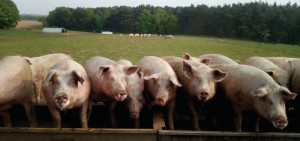
The investigations have helped gain a better insight into the many challenges outdoor herds face in protecting the health of free-draining soils and groundwater quality. They’ve also demonstrated how using a pig-specific grass seed mixture can increase the resilience of the ley and deliver measurable benefits to pig welfare, husbandry, cropping and the environment.
Carried out at LSB Pigs’ 1,200-sow weaner production sites in North Norfolk, the project evaluated two seed mixtures, one a Kings specific pig mix containing perennial ryegrass varieties and a high percentage of creeping red fescue (CRF), the other a typical stewardship blend with ryegrass, legumes and flowering herbs, including vetch, birdsfoot trefoil and red clover. The findings were presented at a recent producer/stakeholder meeting at Swaffham, Norfolk, and clearly demonstrated how a well-established, well-maintained grass sward can positively influence soil health and nutrient retention.
BEHAVIOURAL CHANGES
Observations at LSB’s Coxford site (900 sows) revealed how sows kept on grass were less likely to root, preferring to graze rather than dig up the turf. Dunging behaviour changed too, delivering a more even distribution of organic nutrients across each paddock, which is likely to reduce the occurrence of nitrate-heavy hotspots – an issue often associated with cereal lodging in subsequent cultivations.
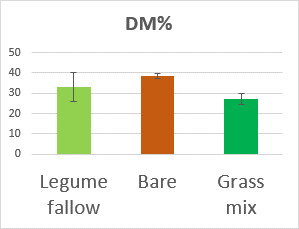
Dung analyses after the first year (September 2021) showed no measurable differences between sows managed on either of the two leys (see Chart 1: green bars).
However, the dry matter content of droppings from sows on grass, compared with sows on bare ground sites (brown bar), was consistently lower. It also contained a higher percentage of organic matter. This evidence supports stockmen observations of fewer constipation episodes, particularly with farrowing sows.
Regular soil sampling throughout the three-year trial showed continual improvements to soil nutrient levels and that having grass cover improved soil mineral nitrogen (SMN), enabling it to build up over time. Paddocks that were weedy with bare patches (mostly the legume/herb ley) were capable of accumulating N, especially if conditions were dry over winter. The paddocks sown with the CRF-based seed mix, however, showed better nutrient retention and greater resilience to pig activity during winter months.
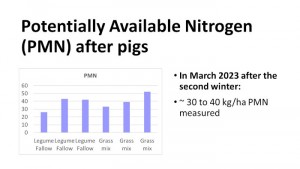
Although SMN levels fluctuated, depleting during winter months where green cover was poor, as is typical with free-draining soils, an overall increase of, on average, 50 kg/ha, was achieved during the trial. In March 2023, following the second winter, the potentially available nitrogen after pigs on all paddocks was measured at 30-40 kg/ha (see chart 2).
Fiona Wood, catchment management scientist at Anglian Water, said the data collected indicated that soil nutrients tend to dissipate more readily during winter when green cover/root structure is poor. Autumn soil N build-up appears less under grass in winter, but seems to be more stable, even in wet conditions, with a significant amount of N held in the green biomass, that would be released over following seasons.
“Further investigations are needed to determine how the grass sward is retaining this additional nitrogen and when these nutrients are subsequently released, but this trial certainly indicates that very useful levels of N are left in the soil after pigs,” she said. “The next step is to find out how arable farmers can successfully manage the release of these valuable nutrients so they can make the most of them with subsequent crops. Timing of sward destruction is key here, avoiding the autumn to maximise plant uptake and minimise environmental risks.”
GROUNDED IMPROVEMENTS
Summarising the practical aspects of the trial, LSB farm manager Rob McGregor explained how retaining grass cover had benefitted pig welfare and improved ground conditions. Sows were noticeably more content, fitter and easier to keep in optimum condition. They have experienced fewer farrowing difficulties since they’ve had the option to graze and the whole system now seems ‘less stressed’.
Keeping a good level of green cover across the unit is helping to control excessive run off and prevent deep gullies developing during periods of heavy rainfall, particularly during winter months and extreme weather conditions.
Mr McGregor reported no severe surface damage or excessive waterlogging during the trial period, despite frequent episodes of high rainfall. Having grass cover has significantly improved the water-holding capacity of the free-draining land and more of the rain water now soaks into the ground rather than flowing down channels and trackways as happened previously.
“Rain water tends to filter steadily through the paddocks now, which didn’t happen when we kept the herd on stubble or bare ground,” he said.
Another sizeable benefit of grass cover has been noted with straw consumption. Huts do not need bedding-up so often as sows no longer eat their bedding – they graze instead and their beds stay dry and clean for longer because paddocks rarely become waterlogged and muddy.
“The time saved bedding-up is significant, and with labour at a premium that’s made a huge difference to daily management. We also had 300 half-heston bales left at the end of June 2023, which was a first, as pig numbers have not changed and we’ve had a fairly long, cold, wet winter,” he added.
With straw around £45 a tonne and around 100 tonnes in store and harvest approaching, that’s some saving. Add this to lower handling/fuel costs, fewer man hours and the benefits to herd management, pig welfare and daily husbandry, and the advantages of having grass under pigs become more economically relevant.
Mitigating environmental risk and protecting the soil might be fundamental objectives, but the value of green cover extends beyond them.
CREEPING GRASS A PANACEA FOR PIGS AND PADDOCKS
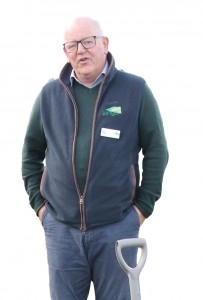
Jim Egan, technical adviser with Kings, has monitored the agronomic value and performance of the grass seed mixes used at LSB throughout the trial. The study indicates that using creeping red fescue in a purpose-designed seed mix provides the resilience needed to maintain green cover on commercial outdoor sites, he said.
“This trial proves that blends which include CRF are persistent and much more resilient to pig traffic than traditional herbage leys or standard commercially available grass mixes. The more cover that can be retained while pigs are in production, the better the outcomes for all involved,” Mr Egan explained.
At LSB’s Coxford unit, both leys produced good swards that could be maintained. However, the paddocks growing Kings’ CRF-based pig mix proved more robust, with dense growth (leaf and roots) and displayed fewer weed incursions with less poaching.
In the dry sow paddocks, where pigs were set stocked and remained on the same area of land for the longest period, a ‘flip grazing’ system was developed that enabled part of the paddock to be rested during occupation. The pig-specific CRF leys showed fewer bare patches while sows were grazing and, when rested, they recovered quickly with good tillering and leaf growth.
The legume/herb leys recovered well when rested, but the response was not as vigorous and bare ground was still visible in some paddocks when pigs returned. The CRF paddocks also proved more robust during extreme weather episodes, proving to be a more resilient surface in drought and high rainfall conditions.
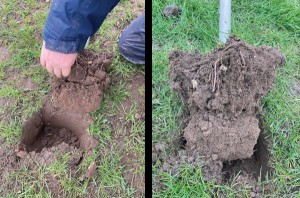
The continual monitoring of soils across LSB’s Coxford unit during the trial has also demonstrated how the fibrous root system developed in the pig-specific CRF leys helps bind soil particles together and improve structure so it is better able to withstand extreme weather. Even when the surface is bare, the robust root network remains active, ready to grow new grass once the ground is given an opportunity to recover.
“Less than 10% cover was lost in flipped grazed paddocks that were sown with our creeping red fescue pig mix during the three-year trial period,” said Mr Egan. “The ground is still green, with fewer weeds and a very healthy soil structure underneath, even as the pigs are coming off and that’s a huge advantage for pig farmers and landowners. This trial demonstrates CRF is a vital part of pig-specific grass mixtures.”
THE SWAFFHAM PROJECT
The Swaffham project began in 2016 as a response to the need to safeguard the outdoor pig industry. An increase in incidents related to outdoor pig rearing and their potential impact on water sources, both above and below ground, prompted AHDB to bring together producers and water stakeholder groups to find solutions to reducing the environmental impact of outdoor pig farming. East Anglian pig producers, their landlords and organisations including Norfolk Rivers Trust, Anglian Water, Catchment Sensitive Farming (CSF), the Environment Agency and Kings Crops, came together to work collaboratively to look at how to improve the relationship between pigs and the environment. A series of workshop sessions focused on topics covering protecting water, preserving soil health, minimising nitrate pollution and preventing erosion.
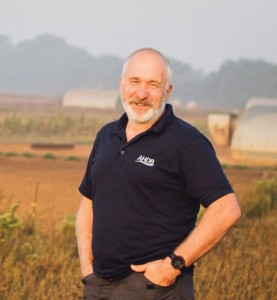 “With most outdoor herds on rented arable land, collaboration is crucial between pig keepers and their landlords,” said Andrew Palmer, AHDB’s pork knowledge exchange relationship manager for the east. A better understanding of site location and source protection zones, along with manure heap locations were some of the early learnings. Herd managers were encouraged to become more adept at land management and most outdoor pig people can now include grassland management and ground care among their pig husbandry skills.”
“With most outdoor herds on rented arable land, collaboration is crucial between pig keepers and their landlords,” said Andrew Palmer, AHDB’s pork knowledge exchange relationship manager for the east. A better understanding of site location and source protection zones, along with manure heap locations were some of the early learnings. Herd managers were encouraged to become more adept at land management and most outdoor pig people can now include grassland management and ground care among their pig husbandry skills.”
As the workshops continued, the focus moved on to include outdoor enterprises in landlords’ arable rotations and a better understanding of emerging environmental schemes and how pigs could benefit. Along with environmental scheme payments, the water stakeholder groups funded specific projects that looked at including buffer strips, sediment traps, and gateway relocation infrastructure projects to avoid serious run-off from fields, preventing water contamination from soil sediment as a result of being washed off fields and roadways.
“An improved awareness and adoption of best practice by the pig keepers when planning which fields to occupy and for how long resulted in more proactive conversations with their landlords and an improvement in site management, all because of the Swaffham workshops,” added Mr Palmer. “We started to see some early work around the use of grass swards on some outdoor units and the benefits of using cover crops.” This led to Norfolk Rivers Trust, Anglian Water, and Kings Crops running the two-year trial with LSB pigs on its outdoor unit to look at how grass cover mixes could improve soil management, the results of which were presented by LSB Pigs unit manager Rob McGregor at the most recent Swaffham workshop.
The second part of the meeting looked towards the future as grants and environmental rotation mixes become more readily available and accessible for the outdoor sector. The meeting ended with a determination to continue to work together and share findings with a wider audience. “The proactive work over the lifetime of the project has started to make a real difference and is now starting to spread beyond the eastern region,” said Mr Palmer. “With environment schemes becoming more attractive to landowners, hopefully, we will see pigs on grass becoming the norm as producers and landlords work together to benefit each other and the environment.”




